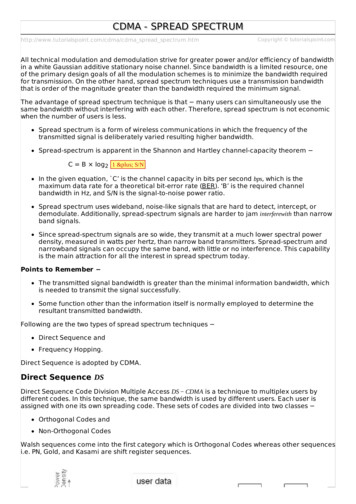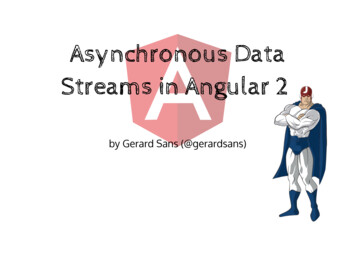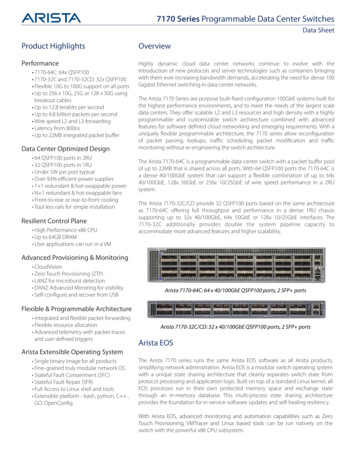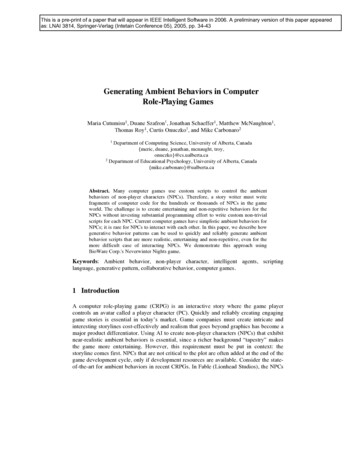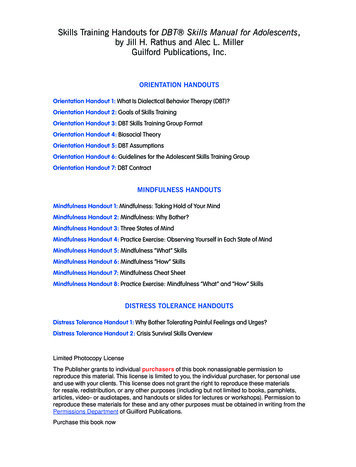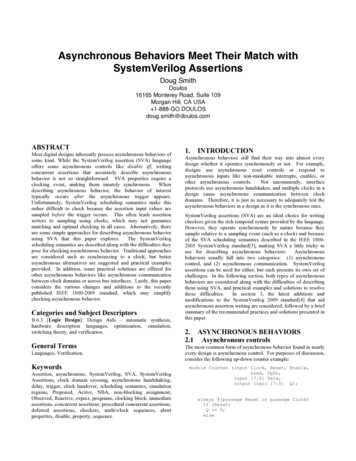
Transcription
Asynchronous Behaviors Meet Their Match withSystemVerilog AssertionsDoug SmithDoulos16165 Monterey Road, Suite 109Morgan Hill, CA USA 1-888-GO DOULOSdoug.smith@doulos.comABSTRACTMost digital designs inherently possess asynchronous behaviors ofsome kind. While the SystemVerilog assertion (SVA) languageoffers some asynchronous controls like disable iff, writingconcurrent assertions that accurately describe asynchronousbehavior is not so straightforward. SVA properties require aclocking event, making them innately synchronous. Whendescribing asynchronous behavior, the behavior of interesttypically occurs after the asynchronous trigger appears.Unfortunately, SystemVerilog scheduling semantics make thisrather difficult to check because the assertion input values aresampled before the trigger occurs. This often leads assertionwriters to sampling using clocks, which may not guaranteematching and optimal checking in all cases. Alternatively, thereare some simple approaches for describing asynchronous behaviorusing SVA that this paper explores.The SystemVerilogscheduling semantics are described along with the difficulties theypose for checking asynchronous behavior. Traditional approachesare considered such as synchronizing to a clock, but betterasynchronous alternatives are suggested and practical examplesprovided. In addition, some practical solutions are offered forother asynchronous behaviors like asynchronous communicationbetween clock domains or across bus interfaces. Lastly, this paperconsiders the various changes and additions to the recentlypublished IEEE 1800-2009 standard, which may simplifychecking asynchronous behavior.Categories and Subject DescriptorsB.6.3 [Logic Design]: Design Aids – automatic synthesis,hardware description languages, optimization, simulation,switching theory, and verification.General TermsLanguages, Verification.KeywordsAssertion, asynchronous, SystemVerilog, SVA, SystemVerilogAssertions, clock domain crossing, asynchronous handshaking,delay, trigger, clock handover, scheduling semantics, simulationregions, Preponed, Active, NBA, non-blocking assignment,Observed, Reactive, expect, programs, clocking block, immediateassertions, concurrent assertions, procedural concurrent assertions,deferred assertions, checkers, multi-clock sequences, abortproperties, disable, property, sequence.1.INTRODUCTIONAsynchronous behaviors still find their way into almost everydesign whether it operates synchronously or not. For example,designs use asynchronous reset controls or respond toasynchronous inputs like non-maskable interrupts, enables, orother asynchronous controls.Not uncommonly, interfaceprotocols use asynchronous handshakes, and multiple clocks in adesign cause asynchronous communication between clockdomains. Therefore, it is just as necessary to adequately test theasynchronous behaviors in a design as it is the synchronous ones.SystemVerilog assertions (SVA) are an ideal choice for writingcheckers given the rich temporal syntax provided by the language.However, they operate synchronously by nature because theysample relative to a sampling event (such as a clock) and becauseof the SVA scheduling semantics described in the IEEE 18002005 SystemVerilog standard[3], making SVA a little tricky touse for describing asynchronous behaviors.Asynchronousbehaviors usually fall into two categories: (1) asynchronouscontrol, and (2) asynchronous communication. SystemVerilogassertions can be used for either, but each presents its own set ofchallenges. In the following section, both types of asynchronousbehaviors are considered along with the difficulties of describingthem using SVA, and practical examples and solutions to resolvethese difficulties.In section 3, the latest additions andmodifications to the SystemVerilog 2009 standard[4] that aidasynchronous assertion writing are considered, followed by a briefsummary of the recommended practices and solutions presented inthis paper.2. ASYNCHRONOUS BEHAVIORS2.1 Asynchronous controlsThe most common form of asynchronous behavior found in nearlyevery design is asynchronous control. For purposes of discussion,consider the following up-down counter example:module Counter (input Clock, Reset, Enable,Load, UpDn,input [7:0] Data,output logic [7:0] Q);always @(posedge Reset or posedge Clock)if (Reset)Q 0;else
if (Enable)if (Load)Q Data;elseif (UpDn)Q Q 1;elseQ Q - 1;endmoduleAs one might expect, this counter has an asynchronous reset toinitialize the module upon power-up or system reset. Thecounter’s behavior is defined in Table 1.Table 1. Truth table of up/down counter functionality.ResetClockEnableLoadUp1Dn0Datanext -Q-1Q 11Using concurrent SystemVerilog assertions, checkers can beeasily written to cover the functionality in the counter truth table.For example, several assertions could be written as follows:default clocking cb @(posedge Clock);endclocking// Enableassert property ( !Enable Q past(Q) );// Load of dataassert property ( Enable && Load Q past(Data) );// Up countingassert property ( Enable && !Load && UpDn Q past(Q) 8'b1 );// Down countingassert property ( Enable && !Load && !UpDn Q past(Q)-8'b1 );2.1.1Figure 1. Asynchronous control in a precondition results infalse failures.The most appropriate approach to cope with the asynchronousreset is to use the SystemVerilog disable iff construct. Disable iffprovides a level-sensitive control to automatically stop newassertion evaluations and terminate active threads. To fix theassertions in this example, each assertion should have an abortcondition specified by adding a disable iff clause in order to workproperly in all situations:// Enableassert property ( disable iff( Reset ) !Enable Q past(Q) );// Load of dataassert property ( disable iff( Reset ) Enable &&Load Q past(Data) );// Up countingassert property ( disable iff( Reset ) Enable&& !Load && UpDn Q past(Q) 8'b1 );// Down countingassert property ( disable iff( Reset ) Enable &&!Load && !UpDn Q past(Q)-8'b1 );Disable iffThese concurrent assertions are fairly straightforward; however,they neglect the effect of an asynchronous reset during theassertion evaluation. If a reset occurs, these checks mayimmediately become invalid. A common mistake is to place theasynchronous control signal in the precondition (also referred toas the antecedent) of the assertion. Adding the asynchronouscontrol into the assertion’s precondition stops the evaluation ofany new assertion threads, but it fails to affect any existingassertion threads. For example, Figure 1 shows how adding thereset to the precondition seems like it will work, but actuallyresults in false failures.Guideline 1: Always use disable iff to asynchronouslyterminate active assertions threads.2.1.2Checking asynchronous eventsWhile disable iff handles asynchronous assertion termination,what if the asynchronous behavior is the thing to be checked? Inthe simple counter example, one check is missing—does Q go to 0immediately upon reset? Since concurrent assertions require asampling event, one might be tempted to write a concurrentassertion as follows:assert property(@(posedge Reset) Reset - Q 0 );1SystemVerilog defines two types of assertions: (1) immediateand (2) concurrent. Immediate assertions are created by usingassert() in a procedural block of code like always or initial.Concurrent assertions create their own thread of execution waitingfor the particular property or sequence to occur, creatingindependent checkers.At first glance, this looks like it works because Q is being checkedfor 0 after the reset signal occurs. However, that is not actuallythe case. In order to understand what is happening, theSystemVerilog scheduling semantics need to be considered.
Before SystemVerilog, a Verilog simulation only had a fewscheduling regions: active, inactive, non-blocking assignment(NBA), and the monitor/strobe regions. All blocking assignmentsand statements are scheduled in the active region, while nonblocking assignments are scheduled to evaluate later after allactive assignments and statements have been executed. This givesnon-blocking assignments their characteristic behavior ofupdating at the end of a simulation time slot.SystemVerilog, on the other hand, has greatly expanded thenumber of simulator regions in order to evaluate correctly the newconstructs introduced like assertions, clocking blocks, andprograms. The Preponed region was introduced to properlyhandle assertions. As simulation time advances, the Preponedregion is at the beginning of each new simulation time slot andproceeds before any events or assignments are generated fromalways or initial blocks (see Figure 2). The SystemVerilogstandard requires that all values used to evaluate concurrentassertions must be sampled during the Preponed region ([3],section 17.3). This means that the values are always sampledbefore any sampling event triggers the assertions to evaluate,making all assertions synchronous to the sampling event andavoiding any changes or metastability issues on the assertioninputs.illustrates this point. The assertion could be re-written to use@(negedge Reset) instead, but the behavior of Q duringreset might be unstable and that would never be detected by thecheck.Figure 3. Signals that change asynchronously are notavailable immediately in concurrent assertions.The solution to the problem is to sample the input values at adifferent simulation time. Therefore, the key to checkingasynchronous behavior after an asynchronous control is to delayeither the evaluation of the check or the sampling of the assertioninputs. There are many ways to accomplish this and the followingoffers some possible solutions.Guideline 2: The key to checking asynchronousbehavior is to delay either the evaluation of thechecking or the sampling of the assertion inputs.2.1.2.1 Synchronously checkingThe most common way to check asynchronous behavior is tosynchronously sample the assertion inputs. While this is usuallysufficient, it is essentially a “cheat” and lacks the assurance thatall behavior has been thoroughly checked (see Figure 4).Figure 2. SystemVerilog scheduling regions.Unfortunately, the way the concurrent assertion semantics aredefined makes it difficult to check asynchronous behavior duringthe same time slot as the asynchronous event. In the simplecounter example, the assertion above will never succeed for tworeasons. First, the precondition checks to see if Reset is 1, whichseems sensible since a posedge Reset triggers the assertion.However, assertions use input values sampled in the Preponedregion, or the value just before the posedge Reset occurs; i.e., avalue of 0. Since Reset equals 0, the precondition alwaysevaluates false. A way to work around this would be to set theprecondition to true in order to force the check:assert property(@(posedge Reset) 1 - Q 0 );Using this precondition causes the assertion to evaluate, but raisesa second issue. As with the Reset value, the value of Q willalways be the value before the posedge of Reset. Considering thesimple up-down counter, Q is reset to 0 using a non-blockingstatement, which means that Q does not update until the NBAregion long after Q is sampled in the Preponed region. Figure 3Figure 4. Synchronously sampling asynchronous behavior.Sometimes, the clock frequency may not be fast enough to samplethe asynchronous behavior so an oversampling fast clock could be
used. Often, this is used with hardware emulators or to catchglitches that occur on the asynchronous signals. Even so, it is theauthor’s opinion that synchronous sampling of asynchronousbehavior should only be used when necessary since there arebetter asynchronous ways to write checkers that do not open thepossibility of missing spurious transitions between samplingevents.2.1.2.2 Immediate assertionsImmediate assertions have the advantage that they evaluate at thepoint that they are executed whichever simulation region that maybe. Using immediate assertions, the asynchronous reset assertioncould be written as:always @( posedge Reset ) assert( Q 0 );As with the earlier concurrent assertion example, this looks like itshould work; however, again there is the issue of when theimmediate assertion evaluation takes place. Immediate assertionsexecute by default in the Active scheduler region. In the design, Qis being updated by a non-blocking assignment so it is beingupdated after the assertion check evaluates during the NBA region.Considering Figure 2, the only way for the checking of Q toevaluate correctly is for the assertion to execute in either theObserved, Reactive, Re-inactive, or Postponed regions since theyall evaluate after the design has updated the value of Q in the NBAregion.2 The Postponed region is only available to PLI routines(like monitor and strobe) or clocking block sampling, leavingthe Observed, Reactive, and Re-inactive regions to evaluate theassertion. There are several easy approaches to accomplish this:use a (1) program block, (2) a sequence event, (3) the expectstatement, (4) a non-blocking trigger event, or (5) a clockingblock.2.1.2.2.1Program blocksProgram blocks are designed intentionally to execute after allevents are evaluated in the design in order to avoid raceconditions between the testbench and the design. A programblock’s inputs are sampled in the Observed region, and any initialblocks within a program are scheduled to execute in the Reactiveregion ([3], section 16.3). By placing the immediate assertion in aprogram, Q will have the reset value when the check is evaluated.program tester;initial forever@(posedge Reset) assert( Q 0 )else error( "Q ! 0 after reset!" );endprogramNote, program blocks can be nested inside of modules orinterfaces so that they have visibility to signals in the local scope,but not all simulators support nested programs. Thus, onedisadvantage to this approach is that it requires hierarchicalreferences to probe the design signals, unless the program isbound (using bind) into the design hierarchy.2.1.2.2.2Sequence eventsA sequence event is an alternate approach to using programs.Sequences define a series of temporal events and can be used toblock the execution of statements until the sequence has beenmatched. The SystemVerilog standard defines that the end-pointstatus for a sequence is set in the Observed region of simulation.Therefore, waiting upon the completion of a sequence by eitherusing a sequence method like .ended, .matched, or .triggered, orusing @(sequence) will delay the execution of subsequentstatements until after the Observed region ([3], sections 10.10.1and 17.12.6).For example, the same reset check could be written as:sequence reset s;@(posedge Reset) 1;endsequencealways @(reset s) assert( Q 0 );The advantage of using sequence events is that each asynchronouscontrol can be defined as a named sequence and then usedappropriately in any always or initial block in modules, interfaces,or programs. Sequence events provide a great alternative to delayassertion input sampling, but be aware that not all simulation toolsfully support them yet.2.1.2.2.3Expect statementsPerhaps providing the best compromise between immediate andconcurrent assertions is the SystemVerilog expect statement.Expect is a procedural statement for use within always or initialblocks, but it also understands the temporal property syntaxavailable to concurrent assertions. For example, an expectstatement can use properties such as this:initialexpect( @(posedge clk) a ##1 b ##1 c ) else error;Fortunately, expect is a great construct for checking asynchronousbehaviors. The SystemVerilog standard states that the statementafter expect is executed after the Observed region ([3], section17.16). Therefore, using expect, immediate assertions can beexecuted after the Observed region as follows:alwaysexpect(@(posedge Reset) 1) assert( Q 0 );Unfortunately, not all major simulators execute the expectstatement and subsequent statements after the Observed region.To compensate, the assertion evaluation can be delayed to at leastthe NBA or Observed region by waiting for the change to occur onQ:alwaysexpect(@(posedge Reset) 1) @Q assert( Q 0 );2There are also several regions not shown in Figure 2 that areprovided for PLI such as the Post-NBA, Post-Observed, and PrePostponed regions, which would also suffice. While PLI could beused to check asynchronous behaviors, it is the author’s opinionthat PLI is considerably more complicated than the simpleapproaches presented in this paper and are therefore notconsidered.However, waiting for Q to change may be problematic. Forinstance, if Q is already 0 when Reset occurs, then the assertionwould fail to check until the first non-zero change of Q, resultingin a false failure. Instead, the expect statement can be placedinside of a program block to delay the sampling of the assertioninputs:
program tester;initial foreverexpect(@(posedge Reset) 1) assert( Q 0 );endprogram2.1.2.2.4Non-blocking event triggerAnother trick to delay the sampling of an immediate assertion’sinputs is to use a non-blocking event trigger (- ). TraditionalVerilog provides an event trigger (- ) that is evaluatedimmediately and only for the current simulation time step. Thenon-blocking event trigger delays its evaluation to the nonblocking assignment (NBA) region of the current or future timestep. In the counter example, Q is updated in the NBA regionusing a non-blocking assign. By waiting for a non-blocking eventtrigger, the assertion is also delayed until the NBA region. Forexample,always @(posedge Reset)beginevent t;- #0 t;@(t) assert ( Q 0 );endHowever, this non-blocking trigger evaluates during the samesimulation time as the RTL is resetting Q, which essentiallycreates a race condition depending on the order that the simulatorevaluates the two processes. In some simulators, the nonblocking trigger always occurs at the appropriate time after theRTL has been updated; in others, it depends on whether theassertion is co-located with the RTL code or in a separate module.In order to guarantee the correct input sampling, a #0 delay can beplaced before the assertion to cause the assertion to be furtherdelayed until the RTL has finished evaluation:always @(posedge Reset)beginevent t;- t;@(t) #0 assert ( Q 0 );endAs the simulator processes the NBA events, they are promoted tothe Active region where they are evaluated as shown in Figure 5:The assertion is further delayed to the Inactive region, causing theRTL assignment to Q to always evaluate beforehand regardless ofthe order that the non-blocking events were scheduled. Using the#0 delay, the race condition between non-blocking events iseliminated and the assertion can be placed either in the RTL codeor elsewhere. Incidentally, until recently not all major simulatorssupported non-blocking event triggering, but now the latestversions generally have good support.2.1.2.2.5Clocking blocksClocking blocks can delay the sampling of inputs used inimmediate assertions. By default, clocking blocks sample using#1step, which is equivalent to the Postponed region of theprevious time slot or the Preponed region of the current.Sampling can be delayed until the Observed region by specifyingthe input delay to be #0 instead. By using a clocking block inputin the immediate assert, the value of Q will already be updatedfrom asynchronous reset:clocking cb @(posedge Reset);input #0 Q;// Delay samplingendclockingalways @(posedge Reset)assert( cb.Q 0 );Notice that the clocking block samples with respect to theasynchronous reset. Because the input delay is specified as #0,the value used for Q comes from the Observed region after theupdated RTL reset value was set in the NBA region.Using the reset as the clocking block’s sampling event creates apotential race condition between updating the clocking variablecb.Q and sampling cb.Q from the assertion the first time Resetoccurs. Assuming Q is 4-state and the assertion process evaluatesfirst, then a erroneous value of X will be sampled before theclocking variable cb.Q is updated, resulting in a false failure.With some simulators, it is enough to wait on the clocking blockbefore evaluating the assertion like this:always @(posedge Reset)@cb assert( cb.Q 0 );Given the possibility of a false failure, this method should be usedwith care.Guideline 3: Immediate assertions can checkasynchronous events if evaluated in the Observed orReactive simulation regions.2.1.2.3 Concurrent assertionsFigure 5. Verilog indeterminacy does not affect the assertionevaluation when using a non-blocking trigger and #0 delay.While concurrent assertions sample synchronously and so have adisadvantage when used for asynchronous checking, there are afew tricks to make them work without resorting to sampling off aclock. As previously discussed, the key to checking asynchronousbehaviors is to delay the checking or the sampling of the inputs.Clocking blocks cannot be used as with immediate assertionsbecause the SystemVerilog standard explicitly states that clockingblock inputs used by concurrent assertions must be sampled using#1step, not #0 ([3], section 17.3). Nonetheless, there is still away to delay the input sampling or the assertion checking bydelaying the sampling trigger or calling subroutine methods usingmatched sequences.
2.1.2.3.1Delaying the asynchronous controlWhile it may seem like “cheating” just like sampling using aclock, delaying the asynchronous control signal slightly to allowthe RTL to finish evaluation is really one of the easiest andsimplest approaches to checking asynchronous behavior. In thecounter example, the original concurrent assertion can be used butwith the Reset signal delayed just enough for the RTL to reset thevalue of Q:assign #1 trigger Reset;assert property( @(posedge trigger) 1 - Q 0);Since there is no unit specified with #1, the delay will be 1 timeunit delay. Normally, this is sufficient but the smallest precisiontime unit could also be used. Some simulators allow the use ofthe #1step keyword, which represents the global time precision:assign #1step trigger Reset;assert property( @(posedge trigger) 1 - Q 0);Using #1step guarantees that no action is missed between thetime slot that the Reset occurs and when the value of Q is reset.Not all simulators implement #1step so a hard coded value isusually adequate.3 Note, using a delay with a continuousassignment statement is easiest, but a separate process could alsobe used to delay Reset or create a named event to trigger theassertion evaluation.task automatic check( ref logic [7:0] data,input logic [7:0] value );assert ( data value );endtaskThe check() task accepts any 8 bit variable or wire andcompares it to value. Notice, the data is passed using ref,which is important because otherwise the Preponed value will bepassed. Since ref is required, the task must be automatic towork properly in some simulators. Now the task can be called ina concurrent assertion in the following manner:assert property( @(posedge Reset) 1 - (1, check( Q, 0 )));or in a named sequence:sequence check q eq 0;(1, check( Q, 8'b0 ));endsequenceassert property( @(posedge Reset) 1 - check q eq 0 );Because the task is evaluated in the Reactive region, the value ofQ is read at that time, giving the updated RTL value after theasynchronous reset occurs. The same could be done with afunction, but not all simulators evaluate functions or sample theirinputs in the Reactive region as the standard specifies.Nonetheless, a generally portable solution is as follows:function bit check q( input logic [7:0] value );return ( Q value );endfunctionassert property( @(posedge Reset) 1 - check q( 0 ));or using a named sequence:sequence checkq;check q( 0 );endsequenceassert property(@(posedge Reset) 1 - checkq );Figure 6. A delayed asynchronous trigger causes Q to besampled at the correct time.2.1.2.3.2Calling subroutines on matched sequencesWhile the SystemVerilog standard restricts the sampling ofconcurrent assertion inputs to the Preponed region (i.e., the valuebefore the sampling event), it does not restrict the sampling of theinputs used by tasks or functions called by an assertion sequence.In fact, a subroutine called by a sequence is specifically defined toevaluate in the Reactive region ([3], section 17.9), allowing theinputs to be sampled after the RTL design has finished updatingfrom any asynchronous events.For example, consider the following task:3One major simulator disallows #1step outside of a clockingblock, but allows the non-standard use of #step in an assignmentstatement to accomplish the same result.The drawback to this approach is that the variable (or wire) beingchecked cannot be passed as an argument but must be hard codedinside the function so that it is sampled at the appropriate time.As a result, using the task version is a more flexible andpreferable solution.Guideline 4:Concurrent assertions can checkasynchronous events by delaying the asynchronouscontrol or calling a subroutine from a matchedsequence.2.1.3 Other Considerations2.1.3.1 Stability checkingIn the simple counter example, checking that the RTL outputs thecorrect value upon an asynchronous control signal is importantand deserves consideration. However, there are other assertionchecks worth considering as well. For example, a check to testthe stability of Q while under reset might also prove useful. Sucha check could simply be written as:assert property ( @(negedge (Q 0)) !Reset );This assertion checks if a non-zero change on Q occurs that itdoes not happens while the device is held under reset. The
assertion could have been written using @(posedge Q), butsimulation tools might interpret this as a non-zero Q[0] or theentire vector Q. Instead, a more cautious approach is preferred ofdetecting a negedge transition using the true/false expressionresult of (Q 0).2.1.3.2 Timing simulationsDelaying the input sampling on an asynchronous assertion workswell as long as there are no timing delays in the design RTL.Most of the methods shown in this section evaluate the assertionsat the same simulation time as the asynchronous control signaloccurs, which would not work with a design that includes delayssuch as a gate-level netlist. In this case, several easy optionsexists that could be used to delayed the assertion checking longenough for Reset to propagate through the design and Q to beupdated:(1) Sample synchronously as shown in 2.1.2.1:assert property (@(posedge Clock) Reset Q 0);(2) Delay the asynchronous control signal as shown in 2.1.2.3.1:parameter gatedelay 10;.assign #gatedelay trigger Reset;assert property( @(posedge trigger) 1 - Q 0);(3) Delay the assertion checking a fixed amount of time:always @(posedge Reset)#gatedelay assert( Q 0 );ORalways @(posedge Reset) beginevent t;- #gatedelay t;@(t) assert( Q 0 );end(4) Delay the assertion checking until the RTL changes:program tester;initial foreverbegin// Signals visible to program@(posedge Reset);if ( Q ! 0 )@Q assert ( Q 0 && Reset );endendprogramOption 1 generally works provided Reset lasts longer than oneclock period; a fast sampling clock could also be used. Options 2and 3 generally work, but may require some trial and error to findthe correct sampling delays that work.Option 4 is essentially immune to timing delays since it triggerson events, but poses its own set of difficulties. First, if Q alreadyequals 0, then the assertion never performs its check (this isrequired if Q equals 0 to prevent a false failure occurring whenReset is released and Q starts changing). Second, in a gate-levelsimulation glitches may occur on Q resulting in false failures.Third, a concurrent assertion cannot be used for this check sincethe value of Q will be sampled in the Preponed region instead ofafter the RTL has updated Q; therefore, the assertion needs to bedelayed using a program block or other method previouslydiscussed in order to correctly sample the assertion’s inputvalue(s). Fourth, there is no guarantee that Q actually changes onthe same Reset that triggered the evaluation! If Q fails to changeand Reset is de-asserted and re-asserted, then the assertion maynot check the value of Q until a subsequent occurrence of Reset.(5) Create a multi-clocked sequence:parameter TIMEOUT 2;.assert property (@(posedge Reset) 1 @(Clock) ##[1:TIMEOUT] Q 0 && Reset);Probably the best compromise is Option 5—sampling using theclock once the Reset triggers the assertion evaluation. Instead ofwaiting for Q to change, a parameterized timeout value can bespecified so if Q never changes before Reset de-asserts then anerror is flagged. This allows the use of a concurrent assertion, andchanging the timeout number of clock edges to sample is muchsimpler than adjusting hard-coded timing delays anytime the gatelevel netlist changes. This type of assertion is referred to as amulti-clocked sequence and is discussed in detail in the nextsection.Guideline 5: For timing simulations, synchronouslychecking the designʼs behavior upon the asynchronousevent is probably the best overall solution.2.2Asynchronous communicationThe second major category of asynchronous behavior isasynchronous communication. In most designs, asynchronouscommunication commonly occurs between two independentclocks domains or with an asynchronous interface protocol.Checking asynchronous communication is usually easier thanasynchronous controls because the signals or data being checkedare typically setup and ready for sampling before the samplingevent occurs. The exception to this occurs between clockdomains when the independent clocks happen to occur at the exactsame simulation time. While this may be unlikely, even if it doeshappen it is usually not a problem because sampling is simplydelayed to the next clock edge; whereas, with asynchronouscontrols, there is no follow
SystemVerilog Assertions Doug Smith Doulos 16165 Monterey Road, Suite 109 Morgan Hill, CA USA 1-888-GO DOULOS doug.smith@doulos.com ABSTRACT Most digital designs inherently possess asynchronous behaviors of some kind. While the SystemVerilog assertion (SVA) language offers some asynchronous controls like disable iff, writing

